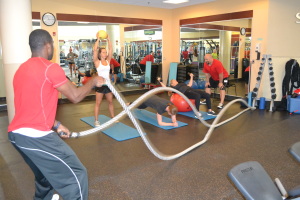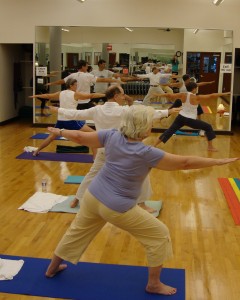by Michelle Sutton-Kerchner
Give your heart a little extra love. Focus on cardio strengthening …
Many benefits of exercise involve its impact on heart health. Directly and indirectly, exercise helps this tireless organ perform its best. Along with strength and flexibility training, every workout should include cardio fitness. Power up the aerobic aspect of your routine with these tips.
Know Your Target Heart Range

Before you begin an exercise program, know your target heart range. This allows you to exercise at your maximum potential and still remain within safe boundaries. The Center nurse can help you determine where your heart rate should be during the various stages of your workout.
Working at 60 to 65 percent of one’s maximum heart rate challenges most exercisers, according to Regional Fitness Manager RJ Pietrucha. He indicates those of higher fitness levels can increase heart rate up to 85 percent. People often work out below these levels, and become disheartened by lack of results. Work with a personal trainer to be sure you are reaching a heart rate that is both effective and safe. You may be just shy of kicking it to the next level.
Multitask Your Strength Training
You can tackle cardio fitness while strength training. Circuit formats are a favorite among trainers because they allow both aerobic and anaerobic exercise. This fitness format is ideal for the time-crunched exerciser. The variety of stations involved also helps avoid stress on any one area of the body. Although not the best choice for the competitive athlete who needs intense endurance training, circuits can be a powerful cardio-strengthening combo.
Increase Intensity on the Exercise Floor

Cross training takes advantage of the Center’s large equipment selection. During a cross training session, one might use the treadmill, stationary bike, and elliptical to work different muscles. “This variety packed into one fitness session maximizes cardio benefits,” notes RJ.
You also can power up your cardio experience on the Exercise Floor by increasing intensity. Adjusting the equipment’s skill level and your speed are two simple ways to challenge your heart’s capacity.
Participate in Group Fitness
Most Group Fitness classes are aerobic in nature. These workouts are easily adapted to your cardio level. A tweak to your timing or positioning can turn a set of squats into a thigh-and-glute-blasting segment with increased cardio perks. Some classes, such as Cycle, encourage participants to wear heart rate monitors. The instructors teach how to maintain, increase, and decrease heart rate throughout the class.
Dance classes like Zumba and Ballroom build a happy heart. Enjoy great cardio fun in the presence of friends and loved ones. Invite your Valentine to join you! Forget the pricey dinner date with calories no one can afford. A whirl in the studio is a healthier way to share the love this season! If you feel uncoordinated or a little stiff, check out aquatic fitness classes. You really can break a sweat in the pool. Impact your cardio health, not your joints.

Some Group Fitness classes do not work the heart in the cardio-building sense, but contribute to heart health in more subtle ways. A Dutch study released in 2014 concluded those who do yoga lowered their blood pressure and cholesterol, two risk factors in developing heart disease. Yoga has not been proven as aerobic exercise, which benefits by raising the heart rate. Rather, it lowers stress, which brings a plethora of health perks to the heart, as well as the entire body and mind.
Yoga improves heart health by down regulating the sympathetic nervous system response (fight-or-flight reaction). This can skyrocket during times of stress, building chronic anxiety. Simultaneously, yoga regulates the parasympathetic response (relaxation reaction). This strengthens your “relaxation muscle.” And who doesn’t need to train that! Other workouts that may mimic this hearty perk include Pilates, T’ai Chi, and Feldenkrais.
Dedicate time in every fitness routine to cardio health. Whether you are pumping up your heart rate or zapping your stress level, your heart will love you for it.
Sources
“Research on Yoga and Heart Disease and What It Means for You,” by Ann Pizer at about.com.
Image Credits
Interval training (introductory photo): flickr.com/photos/kennyholston/5351129140/
 Fitness & Wellness News Your Source for Fitness News, Wellness News, Health News, and Nutrition News!
Fitness & Wellness News Your Source for Fitness News, Wellness News, Health News, and Nutrition News!




